mogrify -implode: Reversible?
-
nmp
- Posts: 3
- Joined: 2018-04-22T14:20:03-07:00
- Authentication code: 1152
- Location: South Side, Chicago
mogrify -implode: Reversible?
Hello,
Is it possible to implode an image then explode it back to the original image? For example:
mogrify -path output_directory1/ -border 20x20 -implode 0.6 -shave 20x20 test.png
cd output_directory
mogrify -path output_directory2/ -border 20x20 -implode -0.6 -shave 20x20 test.png
This naive attempt did not work as the reversed/exploded image was still warped compared to the original. Perhaps the underlying algorithm is not reversible but if it is, I was wondering what parameters would work.
Thanks!
Is it possible to implode an image then explode it back to the original image? For example:
mogrify -path output_directory1/ -border 20x20 -implode 0.6 -shave 20x20 test.png
cd output_directory
mogrify -path output_directory2/ -border 20x20 -implode -0.6 -shave 20x20 test.png
This naive attempt did not work as the reversed/exploded image was still warped compared to the original. Perhaps the underlying algorithm is not reversible but if it is, I was wondering what parameters would work.
Thanks!
- fmw42
- Posts: 25562
- Joined: 2007-07-02T17:14:51-07:00
- Authentication code: 1152
- Location: Sunnyvale, California, USA
Re: mogrify -implode: Reversible?
I do not think it is exactly invertable.
try this and you will see that you do not get the original back.
Even if so, there would be interpolation both ways which would make the final result blurry.
try this and you will see that you do not get the original back.
Code: Select all
convert -size 94x94 xc:red -bordercolor white -border 3 redwhitebox.png
convert redwhitebox.png -virtual-pixel tile -implode 4 -implode -4 tmp.png-
nmp
- Posts: 3
- Joined: 2018-04-22T14:20:03-07:00
- Authentication code: 1152
- Location: South Side, Chicago
Re: mogrify -implode: Reversible?
Blurriness would be fine as I was more interested in returning the original image's geometry...but that's most likely not possible. Thanks.
-
snibgo
- Posts: 12159
- Joined: 2010-01-23T23:01:33-07:00
- Authentication code: 1151
- Location: England, UK
Re: mogrify -implode: Reversible?
I'm curious: why do you want an inverse for implode?
It is possible, but not (I think) by a second implode.
I've looked at the code for implode in fx.c. I can't see how to mathematically reverse one implode by another implode. I think that it is self-reversible only at one given radius from the centre.
If you want a similar process that can be used as its own exact inverse, I suggest you design one.
Of course, implode like any geometric transformation does have an inverse, but it isn't a self-inverse. Like most transformations, it is many-to-one so the inverse has holes. We can make an identity displacement map the same size as the input image (eg toes.png, which is 267x233 pixels), and apply "-implode" to that, and find the inverse of that, and fill in the holes.
This gives us a displacement map that can implode toes.png, and another displacement map that will distort it back to a close approximation of the input.
We start with a negative implode, -0.6, because that gives fewer holes.
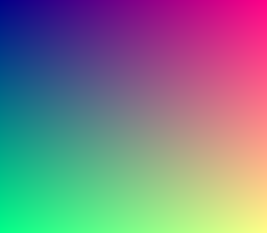
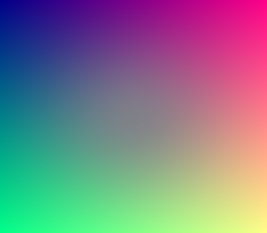
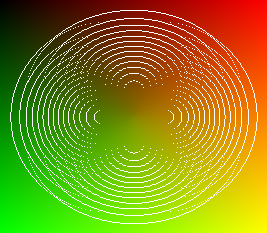
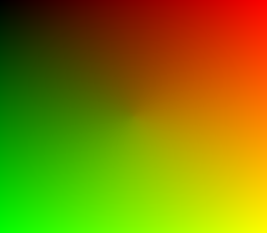
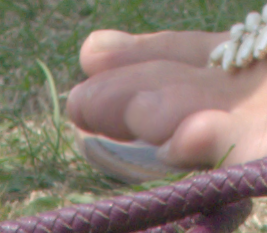
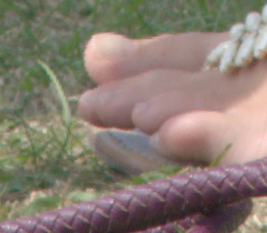
The round-trip is less than 1% different, which isn't visually noticable.
The maps are inverses of each other, so instead of applying the first and then the second, we could apply the second and then the first.
EDIT to add:
1. I expect an exact inverse could be done with a "-fx" operation.
2. My method with displacement maps can be made more accurate by supersampling, eg doubling the sizes reduces the RMSE to 0.0054.
It is possible, but not (I think) by a second implode.
I've looked at the code for implode in fx.c. I can't see how to mathematically reverse one implode by another implode. I think that it is self-reversible only at one given radius from the centre.
If you want a similar process that can be used as its own exact inverse, I suggest you design one.
Of course, implode like any geometric transformation does have an inverse, but it isn't a self-inverse. Like most transformations, it is many-to-one so the inverse has holes. We can make an identity displacement map the same size as the input image (eg toes.png, which is 267x233 pixels), and apply "-implode" to that, and find the inverse of that, and fill in the holes.
This gives us a displacement map that can implode toes.png, and another displacement map that will distort it back to a close approximation of the input.
We start with a negative implode, -0.6, because that gives fewer holes.
Code: Select all
call %PICTBAT%identAbsDispMap 267 233 revi_m.png
Code: Select all
%IM%convert revi_m.png -implode -0.6 revi_i.png
Code: Select all
%IMDEV%convert revi_i.png -process 'invdispmap v' revi_ir.png
Code: Select all
call %PICTBAT%blurFill revi_ir.png . revi_irb.png
Code: Select all
%IM%convert ^
toes.png revi_i.png ^
-compose Distort -set option:compose:args 100%%x100%% -composite ^
revi_t1.png
Code: Select all
%IM%convert ^
revi_t1.png revi_irb.png ^
-compose Distort -set option:compose:args 100%%x100%% -composite ^
revi_t2.png
Code: Select all
%IM%compare -metric RMSE toes.png revi_t2.png NULL:
541.477 (0.00826241)
The maps are inverses of each other, so instead of applying the first and then the second, we could apply the second and then the first.
EDIT to add:
1. I expect an exact inverse could be done with a "-fx" operation.
2. My method with displacement maps can be made more accurate by supersampling, eg doubling the sizes reduces the RMSE to 0.0054.
snibgo's IM pages: im.snibgo.com
-
nmp
- Posts: 3
- Joined: 2018-04-22T14:20:03-07:00
- Authentication code: 1152
- Location: South Side, Chicago
Re: mogrify -implode: Reversible?
Creating an identity displacement map is a fantastic idea. I'll give it a shot.
To answer your question as to why I wish to invert implode, I created a deep learning semantic segmentation model using FCN-8s for axial CT adominal images https://github.com/NVIDIA/DIGITS/tree/m ... al-imaging. In such images, subcutaneous fat (i.e. belly fat) and core skeletal muscle both resemble irregularly-shaped ellipses:

FCN-8s can segment an image down to an 8x8 pixel block. However, extremely fit or extremely sick patients often exhibit very thin subcutaneous fat and/or core muscles layers. These layers often fall below FCN-8s 8x8 pixel resolution threshold and thus are not recognized for segmentation.
Imploded CT images for such patients thickens the fat and muscle rings nicely. Inverting the distorted input image and resulting segmentation mask with your stated level of error would be more than adequate for anatomical segmentation.
To answer your question as to why I wish to invert implode, I created a deep learning semantic segmentation model using FCN-8s for axial CT adominal images https://github.com/NVIDIA/DIGITS/tree/m ... al-imaging. In such images, subcutaneous fat (i.e. belly fat) and core skeletal muscle both resemble irregularly-shaped ellipses:

FCN-8s can segment an image down to an 8x8 pixel block. However, extremely fit or extremely sick patients often exhibit very thin subcutaneous fat and/or core muscles layers. These layers often fall below FCN-8s 8x8 pixel resolution threshold and thus are not recognized for segmentation.
Imploded CT images for such patients thickens the fat and muscle rings nicely. Inverting the distorted input image and resulting segmentation mask with your stated level of error would be more than adequate for anatomical segmentation.
- fmw42
- Posts: 25562
- Joined: 2007-07-02T17:14:51-07:00
- Authentication code: 1152
- Location: Sunnyvale, California, USA
Re: mogrify -implode: Reversible?
Perhaps some other distortion would work better. For example spherical and inverse spherical. See my script http://www.fmwconcepts.com/imagemagick/ ... /index.php as one example. You can also create your own distortions as snibgo suggested and its inverse distortion.
-
snibgo
- Posts: 12159
- Joined: 2010-01-23T23:01:33-07:00
- Authentication code: 1151
- Location: England, UK
Re: mogrify -implode: Reversible?
Ha! Very neat. So you want to implode, segment, then de-implode.nmp wrote:Imploded CT images for such patients thickens the fat and muscle rings nicely.
The "-implode" transformation moves pixels along the radius from the centre:
Code: Select all
r' = pow( sin(PI*r),-amount)A simpler version is:
Code: Select all
r' = pow(r,amount)Here is a script that implements the simple version as a Windows BAT script, squishPow.bat. It is readily translated to bash or anything else. The amount is expressed as numerator and denominator, to simplify the inversion.
Code: Select all
rem From image %1,
rem makes output %2
rem shifting pixels along radius by power factor %3/%4.
set sFX=^
Cx=w/2;^
Cy=h/2;^
Hy=hypot(i-Cx,j-Cy)/hypot(Cx,Cy);^
FF=Hy^>1?1:pow(Hy,%3/%4)/Hy;^
Xs=FF*(i-Cx)+Cx;^
Ys=FF*(j-Cy)+Cy;^
p{Xs,Ys}
%IM%convert ^
%1 ^
-virtual-pixel Black ^
-fx "%sFX%" ^
%2
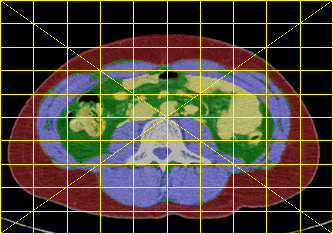
Code: Select all
call %PICTBAT%squishPow abdo_grid.png abdo_g1.png 3 4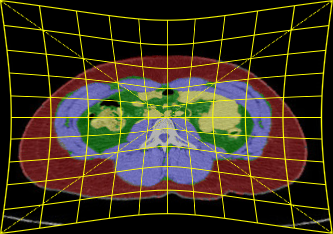
Code: Select all
call %PICTBAT%squishPow abdo_g1.png abdo_g2.png 4 3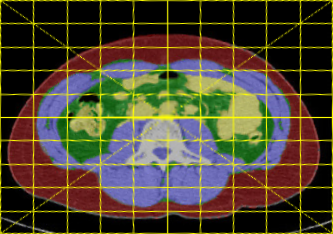
Inevitably, there is fuzziness that increases towards the centre.
We can supersample, eg resize the input by 400%, do the process, and resize the output by 25%, making the round-trip result:
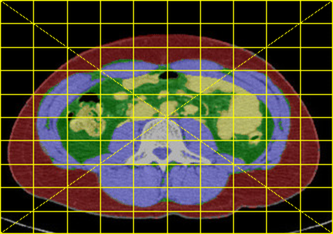
The result is much less fuzzy. You could do the segmentation on the 400% super-sampled image.
The "-fx" operator is interpreted at every pixel, so it is slow, about 6 seconds for this example (supersampling at 400% take 16 times as long). If you need to process many same-sized images, you can create two displacement maps (by applying two transformations to an identity displacement map) and apply those to the images, as in my previous post.
snibgo's IM pages: im.snibgo.com